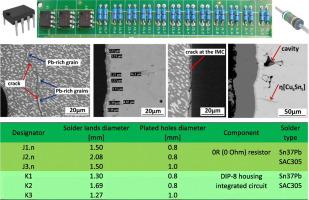Microelectronics Reliability ( IF 1.6 ) Pub Date : 2021-09-13 , DOI: 10.1016/j.microrel.2021.114368 Maciej Sobolewski 1, 2 , Joanna Wojewoda-Budka 1 , Zbigniew Huber 2 , Pawel Zieba 1 , Anna Wierzbicka-Miernik 1

|
Through-hole technology (THT) for the electronic circuits assembly is known for decades and recently is replaced by surface-mount technology (SMT). However, THT method is still widely used in many modern devices, where proper power dissipation is essential. The design for manufacturing (DFM) rules is important for the high reliability of the THT products. The experiment was performed for the various solder lands and hole sizes and two solder materials (lead-free solder Sn3Ag0.5Cu and Sn37Pb) on the printed circuit board (PCB) with the hot air solder leveling finish (HASL), specially designed for this purpose. The various types of THT electronic components were connected in the wave soldering process. Next, the PCB were subjected to the thermal cycles test (550 cycles from −20 °C to +80 °C) to verify the reliability of the solder joints under the extreme working conditions. The scanning electron microscopy (SEM) technique combined with an energy dispersive X-ray spectroscopy (EDS) allowed revealing the microstructure and chemical composition details of the obtained interconnections before and after the thermal tests.
中文翻译:

具有各种焊盘和孔设计的通孔组件的焊点可靠性
用于电子电路组件的通孔技术 (THT) 已有数十年的历史,最近被表面贴装技术 (SMT) 所取代。然而,THT 方法仍然广泛用于许多现代设备,在这些设备中,适当的功率耗散是必不可少的。制造设计 (DFM) 规则对于 THT 产品的高可靠性非常重要。该实验针对印刷电路板 (PCB) 上的各种焊区和孔尺寸以及两种焊料(无铅焊料 Sn3Ag0.5Cu 和 Sn37Pb)进行,热风焊料整平处理 (HASL) 专门为此设计目的。各种类型的 THT 电子元件在波峰焊接过程中连接起来。下一个,PCB 进行了热循环测试(从 -20 °C 到 +80 °C 的 550 次循环),以验证极端工作条件下焊点的可靠性。扫描电子显微镜 (SEM) 技术与能量色散 X 射线光谱 (EDS) 相结合,可以揭示热测试前后获得的互连的微观结构和化学成分细节。











































 京公网安备 11010802027423号
京公网安备 11010802027423号